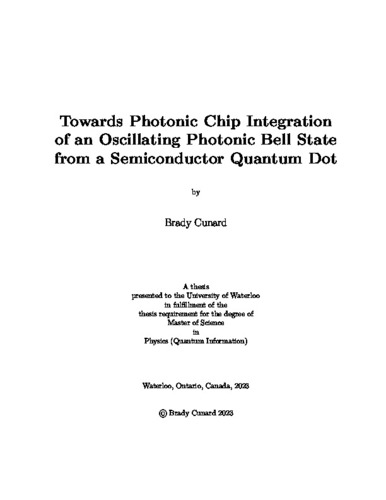| dc.description.abstract | The demand for entangled photon sources has been growing in all areas of quantum information technologies. However, many modern single-photon sources suffer from fundamental limitations which limit their ability to produce these single-photons, as many of the “high quality” sources are probabilistic in nature. This probabilistic emission limits the “on-demand” requirement needed for many quantum information technologies. As a result, other types of single photon sources have been the topic of research for the past two decades, in which quantum dots are a promising candidate. Quantum dots are regions in space which electron-hole pairs can be confined and, using a phenomenon called ”spontaneous emission,” can emit single photons on demand. This is because the creation of electron-hole pairs is a deterministic process, which is a major topic of study in this thesis. In addition, the quantum dot which is the focus of this thesis is capable of emitting pairs of entangled photons on-demand, which have a wide array of applications in the quantum computing community. Our quantum dot is also embedded inside a nanowire, which this thesis will show, improves its performance in the areas which are considered important to the quantum dot, quantum computing, quantum networking, and quantum communication communities.
The nanowire quantum dots, comprised of an InAsP quantum dot embedded in an InP nanowire studied in this thesis show improvements over other quantum dot sources in key areas: photon purity, with a g(2)_XX (0) = 0.0055 ± 0.0003 and g(2)_X (0) = 0.0028 ± 0.0003, and entanglement, with peak concurrence (fidelity) values of C = 95.6 ± 0.7% (F = 97.7 ± 0.4%) and lifetime weighted concurrence (fidelity) of C = 90.2 ± 0.2% (F = 94.0 ± 0.1%). These results are an improvement from previous results on the same nanowire quantum dot, with peak concurrence of C = 87 ± 4% and lifetime weighted concurrence of C = 52 ± 3%.
The reason for the improvements on the same dot is because of the detection systems, superconducting nanowire single photon detectors. These detectors have far less timing jitter, dark counts, and higher efficiency than their counterparts, single photon avalanche diodes, which suggests these quantum dots are far better than previously thought. This thesis explores the effects of the detection systems in resolving a time-dependent oscillating quantum state, which occurs when a quantum dot has a fine-structure splitting. The fine-structure splitting is present in quantum dots that have strain, random alloying, or an asymmetric confining potential, causing asymmetry in the physical dimensions of the quantum dot. This asymmetry causes a lifting in the degeneracy of the exciton state, which causes the exciton state to precess. This oscillation happens on a timescale similar to the single photon avalanche diodes timing jitter, causing a “blurring” of the oscillating quantum state. This is mediated by using faster detectors, which this thesis will explore.
In addition to single photon sources, this thesis also focuses on the creation of photonic integrated circuits capable of supporting the photons emitted from our quantum dot. This is important because our quantum dot emits at wavelengths ≈ 894 nm, which is not supported by the silicon platform typically offered for photonic integrated circuits. This thesis will focus on a new platform, silicon nitride, which is capable of supporting light at our wavelengths. The results of this thesis demonstrate the simulated performance of the silicon nitride photonic integrated circuits at our wavelengths and lay the groundwork for a path forward to testing them with our source. | en |

